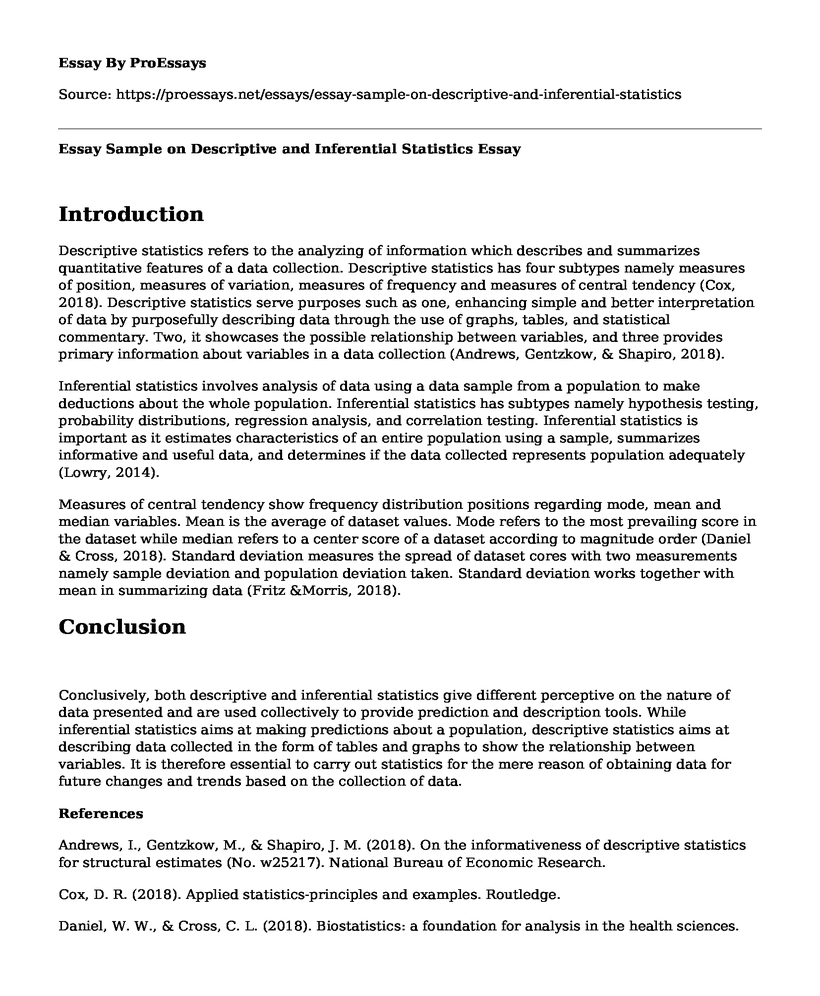Introduction
Descriptive statistics refers to the analyzing of information which describes and summarizes quantitative features of a data collection. Descriptive statistics has four subtypes namely measures of position, measures of variation, measures of frequency and measures of central tendency (Cox, 2018). Descriptive statistics serve purposes such as one, enhancing simple and better interpretation of data by purposefully describing data through the use of graphs, tables, and statistical commentary. Two, it showcases the possible relationship between variables, and three provides primary information about variables in a data collection (Andrews, Gentzkow, & Shapiro, 2018).
Inferential statistics involves analysis of data using a data sample from a population to make deductions about the whole population. Inferential statistics has subtypes namely hypothesis testing, probability distributions, regression analysis, and correlation testing. Inferential statistics is important as it estimates characteristics of an entire population using a sample, summarizes informative and useful data, and determines if the data collected represents population adequately (Lowry, 2014).
Measures of central tendency show frequency distribution positions regarding mode, mean and median variables. Mean is the average of dataset values. Mode refers to the most prevailing score in the dataset while median refers to a center score of a dataset according to magnitude order (Daniel & Cross, 2018). Standard deviation measures the spread of dataset cores with two measurements namely sample deviation and population deviation taken. Standard deviation works together with mean in summarizing data (Fritz &Morris, 2018).
Conclusion
Conclusively, both descriptive and inferential statistics give different perceptive on the nature of data presented and are used collectively to provide prediction and description tools. While inferential statistics aims at making predictions about a population, descriptive statistics aims at describing data collected in the form of tables and graphs to show the relationship between variables. It is therefore essential to carry out statistics for the mere reason of obtaining data for future changes and trends based on the collection of data.
References
Andrews, I., Gentzkow, M., & Shapiro, J. M. (2018). On the informativeness of descriptive statistics for structural estimates (No. w25217). National Bureau of Economic Research.
Cox, D. R. (2018). Applied statistics-principles and examples. Routledge.
Daniel, W. W., & Cross, C. L. (2018). Biostatistics: a foundation for analysis in the health sciences. Wiley.
Fritz, C. O., & Morris, P. E. (2018). Standard Deviation.
Lowry, R. (2014). Concepts and applications of inferential statistics.
Cite this page
Essay Sample on Descriptive and Inferential Statistics. (2022, Oct 27). Retrieved from https://proessays.net/essays/essay-sample-on-descriptive-and-inferential-statistics
If you are the original author of this essay and no longer wish to have it published on the ProEssays website, please click below to request its removal:
- Nursing Research on Distinguishing Between Univariate and Bivariate Statistics Paper Example
- High Standard Deviation for Foreign Cars: Descriptive Statistics
- Abort to Save: Examining the Rights of Living in Contemporary Society.
- My Early Path to a Teaching Career
- Financial Resources & Access to Supermarkets Impact Diet Choices
- Lead Analyst's Challenge: Persuading Stakeholders With Data - Free Report Example
- Free Essay Sample: American and Iranian Views on Resource Scarcity and Conservation







